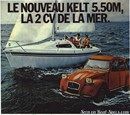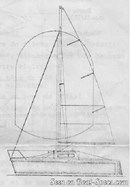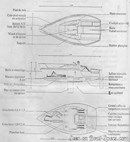Kelt 5.50 Lifting keel
Sailboat specifications
The Kelt 5.50 is a 17’11” (5.45m) cruising sailboat designed by Gilles Ollier (France). She was built between 1978 and 1982 by Kelt (France). The Lifting keel version features an appendage configuration without compromise between draft and performance. Only drawback: some space is taken inside by the keel.
Kelt 5.50's main features
- Model
- Kelt 5.50
- Version
- Lifting keel
- Hull type
- Monohull
- Category
- Coastal cruising sailboat
- Sailboat builder
- Sailboat designer
- Sailboat collection
- Country
- France
- Construction
- GRP (glass reinforced polyester):
- Hull: Single skin fiberglass polyester
- Deck: Sandwich balsa fiberglass polyester - Number of hulls built
- About 600
- First built hull
- 1978
- Last built hull
- 1982
- Appendages
- Lifting keel : retractable fin without bulb
- Helm
- Single tiller
- Rudder
- Single transom hung rudder
- Unsinkable
- Yes
- Trailerable
- Yes
- Former French navigation category
- 5
- Standard public price ex. VAT (indicative only)
- N/A €
Kelt 5.50's main dimensions
- Overall length
- 19’ 7”5.97 m
- Hull length
- 17’ 11”5.45 m
- Waterline length
- 15’ 8”4.8 m
- Beam (width)
- 7’ 11”2.42 m
- Waterline beam (width)
- 6’ 1”1.87 m
- Draft
- 3’ 7”1.1 m
- Draft when appendages up
- 0’ 10”0.25 m
- Mast height from DWL
- 27’ 6”8.38 m
- Fore freeboard
- 2’ 6”0.75 m
- Mid-ship freeboard
- 2’ 5”0.72 m
- Light displacement (MLC)
- 1323 lb600 kg
- Maximum displacement (MLDC)
- 2061 lb935 kg
- Ballast weight
- 220 lb100 kg
- Ballast type
- Lead
- French customs tonnage
- 2.78 Tx
Kelt 5.50's rig and sails
- Upwind sail area
- 199 ft²18.45 m²
- Downwind sail area
- 313 ft²29.04 m²
- Mainsail area
- 113 ft²10.54 m²
- Genoa area
- 85 ft²7.91 m²
- Jib area
- 59 ft²5.48 m²
- Stormjib area
- 31 ft²2.9 m²
- Symmetric spinnaker area
- 199 ft²18.5 m²
- PiMainsail hoist measurement (from tack to head)
- 21’ 4”6.5 m
- EiMainsail foot measurement (from tack to clew)
- 9’ 2”2.8 m
- Rigging type
- Sloop Marconi 7/8
- Mast configuration
- Deck stepped mast
- Rotating spars
- No
- Number of levels of spreaders
- 1
- Spreaders angle
- Swept-back
- Spars construction
- Aluminum spars
- Standing rigging
- Continuous
Kelt 5.50's performances
- HN (French rating)iHN or "Handicap Nationale" is an empirical rating system used in France allowing various monohulls, of different sizes and designs, to race each other fairly. It is particularly suitable for cruiser and cruiser-racer. Therefore, by comparing these values, we can have an indication of the relative speed of 2 boats.
- 3.0
- Upwind sail area to displacementiThe ratio sail area to displacement is obtained by dividing the sail area by the boat's displaced volume to the power two-thirds.
The ratio sail area to displacement can be used to compare the relative sail plan of different sailboats no matter what their size.
Upwind: under 18 the ratio indicates a cruise oriented sailboat with limited performances especially in light wind, while over 25 it indicates a fast sailboat. - 279 ft²/T25.94 m²/T
- Downwind sail area to displacementiThe ratio sail area to displacement is obtained by dividing the sail area by the boat's displaced volume to the power two-thirds.
The ratio sail area to displacement can be used to compare the relative sail plan of different sailboats no matter what their size. - 439 ft²/T40.82 m²/T
- Displacement-length ratio (DLR)iThe Displacement Length Ratio (DLR) is a figure that points out the boat's weight compared to its waterline length. The DLR is obtained by dividing the boat's displacement in tons by the cube of one one-hundredth of the waterline length (in feet).
The DLR can be used to compare the relative mass of different sailboats no matter what their length:
a DLR less than 180 is indicative of a really light sailboat (race boat made for planning), while a DLR greater than 300 is indicative of a heavy cruising sailboat. - 154
- Ballast ratioiThe Ballast ratio is an indicator of stability; it is obtained by dividing the boat's displacement by the mass of the ballast. Since the stability depends also of the hull shapes and the position of the center of gravity, only the boats with similar ballast arrangements and hull shapes should be compared.
The higher the ballast ratio is, the greater is the stability. - 17 %
- Wetted area
- 97 ft²9.05 m²
- Maximum transverse section
- 4 ft²0.34 m²
- Critical hull speediAs a ship moves in the water, it creates standing waves that oppose its movement. This effect increases dramatically the resistance when the boat reaches a speed-length ratio (speed-length ratio is the ratio between the speed in knots and the square root of the waterline length in feet) of about 1.2 (corresponding to a Froude Number of 0.35) . This very sharp rise in resistance, between speed-length ratio of 1.2 to 1.5, is insurmountable for heavy sailboats and so becomes an apparent barrier. This leads to the concept of "hull speed".
The hull speed is obtained by multiplying the square root of the waterline length (in feet) by 1.34. - 5.32 knots
Kelt 5.50's auxiliary engine
- Engine(s)
- 1 outboard engine
Kelt 5.50's accommodations and layout
- Cockpit
- Closed aft cockpit
- Berth(s)
- 4
- Maximum headroom
- 4’ 7”1.41 m
Kelt 5.50's fore cabin
- Berth length
- 6’ 11”2.1 m
- Berth width
- 5’ 11”1.8 m
Kelt 5.50's aft cabin
- Berth length
- 6’ 2”1.9 m
- Berth width
- 2’0.6 m
Similar sailboats that may interest you:
Sailboats
First built hull
Hull length
1978
18’5.5 m
1977
18’ 10”5.74 m
1995
21’ 6”6.55 m
2000
18’5.49 m
1985
22’ 7”6.9 m
1962
17’ 2”5.25 m
1994
16’ 7”5.05 m
1976
19’ 8”6 m
1978
19’ 8”6 m
1999
20’ 4”6.2 m
1970
21’ 8”6.6 m
1973
20’ 4”6.2 m
1974
20’ 4”6.2 m
1995
22’ 6”6.85 m
1989
20’ 8”6.3 m



